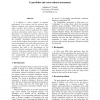Free Online Productivity Tools
i2Speak
i2Symbol
i2OCR
iTex2Img
iWeb2Print
iWeb2Shot
i2Type
iPdf2Split
iPdf2Merge
i2Bopomofo
i2Arabic
i2Style
i2Image
i2PDF
iLatex2Rtf
Sci2ools
ICALT
2006
IEEE
2006
IEEE
E-portfolios and Cross-Cultural Assessment
It is difficult to collect evidence of adequate performance if an assessor and the assessees have different linguistic and cultural backgrounds. This paper considers three entries in student portfolios where the assessor tried to understand the students and their achievement, rather than to rate it. Three approaches were followed: positivist, post-structural /interpretive and feminist/holistic. Sources of data include artifacts produced by students for inclusion in the portfolio, assessment rubrics and assessment scores. Results indicate that portfolio assessment with criteria negotiated between the instructor/assessor, the learners and their peers allow for a rich thick evaluation that adds to the development of the learners. Detailed assessment rubrics stifled student creativity, while open-ended tasks with video feedback enhanced it. Further research needs to be conducted into standardizing the procedures of auditing assessments, rather than standardizing procedures of assessing.
Assessment Rubrics | Data Include Artifacts | Detailed Assessment Rubrics | ICALT 2006 | Machine Learning |
| Added | 11 Jun 2010 |
| Updated | 11 Jun 2010 |
| Type | Conference |
| Year | 2006 |
| Where | ICALT |
| Authors | Johannes C. Cronjé |
Comments (0)

